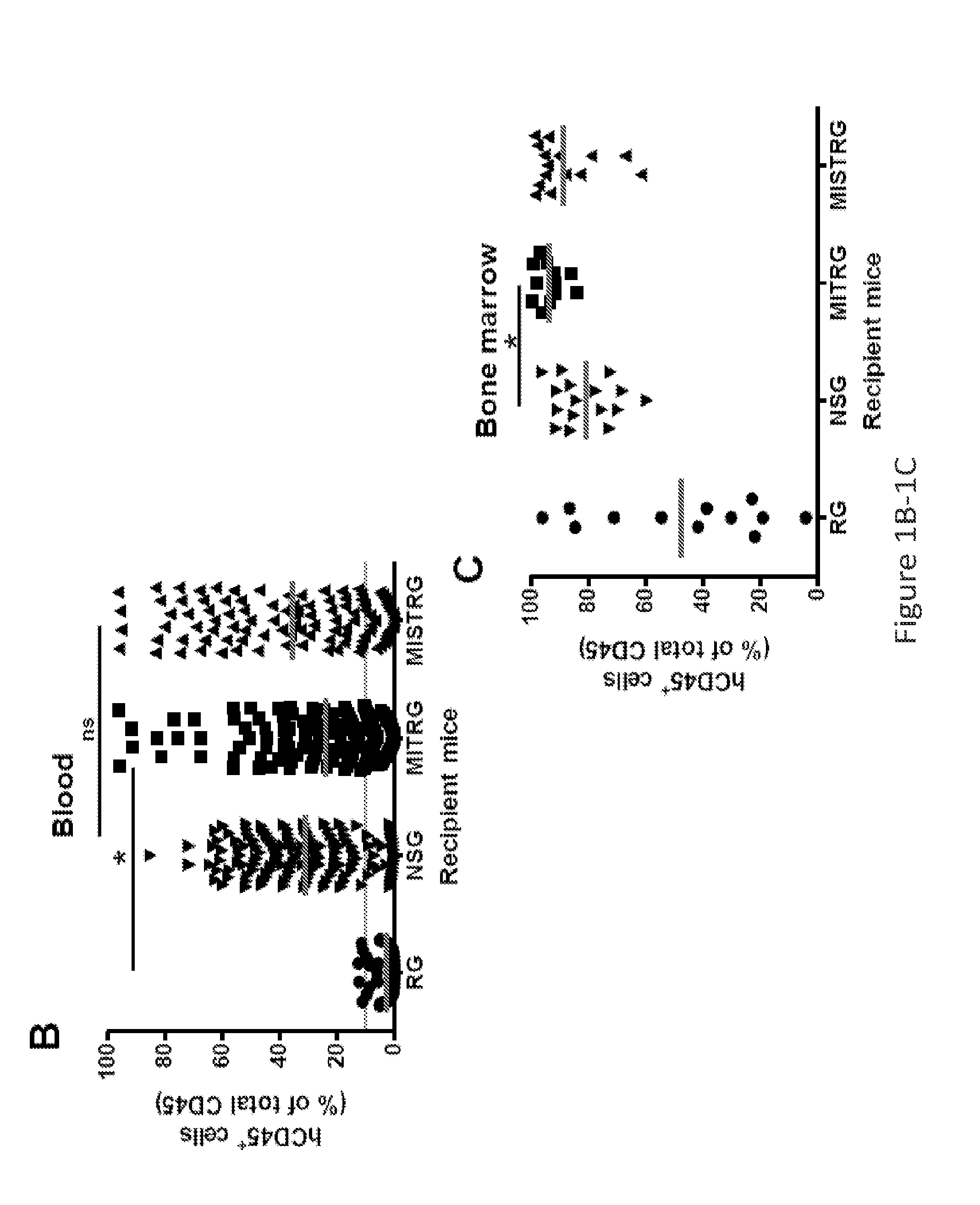Genetically modified non-human animals and methods of use thereof
a non-human animal and gene technology, applied in the field of biomedical research, can solve the problems of human myeloid development being particularly defective in these hosts, and the knowledge gained from animal experimentation is not always applicable to humans
- Summary
- Abstract
- Description
- Claims
- Application Information
AI Technical Summary
Benefits of technology
Problems solved by technology
Method used
Image
Examples
experimental examples
[0102]The invention is further described in detail by reference to the following experimental examples. These examples are provided for purposes of illustration only, and are not intended to be limiting unless otherwise specified. Thus, the invention should in no way be construed as being limited to the following examples, but rather, should be construed to encompass any and all variations which become evident as a result of the teaching provided herein.
[0103]Without further description, it is believed that one of ordinary skill in the art can, using the preceding description and the following illustrative examples, make and utilize the compounds of the present invention and practice the claimed methods. The following working examples therefore, specifically point out the preferred embodiments of the present invention, and are not to be construed as limiting in any way the remainder of the disclosure.
example 1
Functional Innate Immune Responses and Solid Tumor Support in Human-Hemato-Lymphoid System Mice
[0104]As described herein, mice repopulated with a human hemato-lymphoid system (HHLS) represent a powerful tool for predictive human preclinical in vivo research. A major limitation of current HHLS mice is the defective development of human cells critical for innate immunity. Here, a novel mouse strain is reported in which multiple genes encoding cytokines are genetically humanized. These humanized cytokines act synergistically to efficiently support human hematopoiesis and the development and function of human monocytes / macrophages and NK cells. In a tumor microenvironment, human macrophages acquire an immunosuppressive phenotype and support the growth of a human cancer. With a more complete and functional human innate immune system, this novel model of HHLS mice has exceptional potential to facilitate the study of physiology and pathology of human innate immunity in vivo.
[0105]Monocytes...
example 2
Human Myeloid Neoplasms can be Engrafted in MISTRG
[0146]Myeloid leukemia is a form of cancer that affects cells of the myeloid lineage. Myeloid leukemias are classified in different types, including acute myeloid leukemia (AML), myeloproliferative disorder (MPD), chronic myelo-monocytic leukemia (CMML) and myelodysplastic syndrome (MDS). The risk of developing myeloid leukemias increases with age and the incidence of these diseases is likely to increase with ageing of the population. Although therapeutic and supportive care approaches are available in the clinic, a better understanding of this group of diseases and novel therapies are needed.
[0147]One of the methods used to study human leukemias relies on the xeno-transplantation of patient samples into immunodeficient mice. However, currently available recipient mice are not optimal for this purpose: only a subset of AML samples can be engrafted successfully; and robust engraftment of MPD, CMML or MDS (including RCUD, RAEB I and RA...
PUM
| Property | Measurement | Unit |
|---|---|---|
| volume | aaaaa | aaaaa |
| white blood cell | aaaaa | aaaaa |
| frequencies | aaaaa | aaaaa |
Abstract
Description
Claims
Application Information
 Login to View More
Login to View More - R&D
- Intellectual Property
- Life Sciences
- Materials
- Tech Scout
- Unparalleled Data Quality
- Higher Quality Content
- 60% Fewer Hallucinations
Browse by: Latest US Patents, China's latest patents, Technical Efficacy Thesaurus, Application Domain, Technology Topic, Popular Technical Reports.
© 2025 PatSnap. All rights reserved.Legal|Privacy policy|Modern Slavery Act Transparency Statement|Sitemap|About US| Contact US: help@patsnap.com



